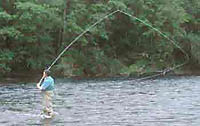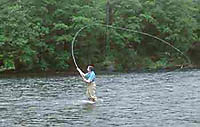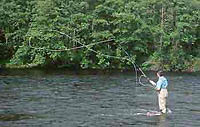Single Spey casting two handed (page 2 of 2)
Most beginners find that the hardest part of making
a good Spey cast is putting the anchor (the fly, leader and a small
amount of line) in the correct location for a successful forward
cast. The anchor must be upstream of the D loop and ideally it should
be almost in line with the direction of the forward cast. |
 |
| Making the D loop |
Making the D loop is really a gentle affair, too much
energy at this stage and the line will go whistling upstream without
making that all important touchdown for the anchor. No anchor and
the D loop cannot be tensioned for the forward cast. |
 |
| Making the forward cast |
Once the D loop is formed the rest is easy. Here you
see the drive of the forward cast, like all Spey casts the rod is
accelerated by pushing with the top hand and pulling with the bottom
hand, a true double handed action. |
 |
| Completing the cast |
The cast should be aimed high (unless a strong upstream
wind is blowing) and the rod tip must be moved in a straight line
if the forward loop is to be kept tight to penetrate the wind. |
 |
| The line is allowed to extend |
Shooting line to obtain greater distances is essential
when Spey casting and the usual principles apply. Line is lengthened
by releasing spare line immediately after the power stroke is completed.
For a visual key, look for the forward loop of line passing the
rod tip, that is the time to release (shoot) line into the cast.
The amount of energy put into the forward cast has to be increased
slightly to take account of any additional length of line being
shot. |




